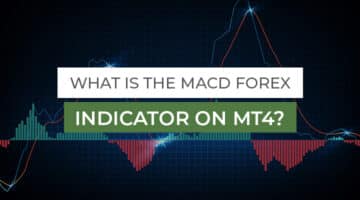Leverage Ratio for Forex Trading

In this article
Leverage is the idea of borrowing and investing the borrowed money in currency, stocks, or securities. Forex traders often use leverage. A trader can trade larger amounts of currency by borrowing funds from a broker. The leverage ratio for forex trading is a very vital concept to understand as it can be detrimental for newbie traders
Because of this, leverage multiplies the benefits of favourable changes in a currency’s exchange rate. Leverage can, however, also magnify losses, making it a double-edged sword. Therefore, a forex trader must understand how leverage works and risk management strategies to mitigate FX losses. Continue reading to find out the maximum leverage you should use to trade.
What is leverage in the Forex market?
Leverage is a loan that an investor receives from the broker. Through leverage, investors can increase their Forex trading profits. The Forex market offers its investors the highest amount of leverage available in the market.
The Forex market is one of the world’s largest trading markets, with daily currency exchanges worth more than $5 trillion. In Forex trading, a trader buys and sells currencies to intend that the exchange rates move in his favour. Then, a Forex broker displays or quotes the currency exchange rates as bid and ask prices.
However, the investors who are interested in longing or buying currency will receive the asking price. In comparison, the investors who wish to sell the currency will receive the bid price.
A Forex trading account allows traders to trade on margin or borrow funds. In the beginning, new traders may have a limit on how much leverage they can use. In some cases, traders can customise the amount or size of their trades according to the desired leverage.
Although, brokers require an initial margin of the trade’s national amount percentage in the trading account.
Rules of leverage determination
Before selecting a leverage level, investors should review universally accepted rules. There are three simple rules for determining leverage:
- Keep leverage to a minimum.
- Put trailing stops in place to protect capital and reduce the downside.
- You should limit the capital you use on each position to 1% to 2% of your total trading capital.
Leverage ratio types
Depending on the size of the trade, each broker may require a different margin. Investors who buy $100,000 worth of EUR/USD might need to hold $1,000 in their account as margin. As a result, the margin requirement is 1%, or ($1,000 / $100,000).
According to the margin example above, one would have a leverage ratio of 100:1 ($100,000 / $1,000). Thus, the investor can, for example, trade $100,000 in a certain currency pair with only a deposit of $1,000.
These values of margin requirements and leverage ratios will help you make sense of them.
| Margin requirements | Leverage ratio |
| 1% | 100:1 |
| 2% | 50:1 |
| 5% | 200:1 |
Leverage ratio as a result of margin requirements
Based on the table above, the greater the leverage allowed, the lower the margin requirement. If the currency being traded requires a higher margin, a broker may charge a higher margin.
A good example of this phenomenon is the British pound’s exchange rate with the Japanese yen, which can fluctuate wildly, causing large swings in the rate. The higher the volatility of a currency or the more volatile the trading period, the more collateral the broker may require (i.e., 5%).
Risk of leverage
Leverage can generate substantial profits for investors but can also work against them. For example, leverage will greatly affect potential losses if the currency underlying a trade moves the opposite way from what you intended.
The use of stop-loss orders is one of the many strategies that forex traders use to avoid catastrophes. Stop-losses are orders placed with a broker to quit a position at a certain point in time. Trading this way allows the traders to limit their losses.
High leverage risks
Investors borrow money to invest in or buy something via leverage. Most forex traders acquire capital from brokers. The margin requirements allow forex traders to borrow considerable amounts of capital; however, they can gain much more from successful trades.
Brokers were once able to offer leverage ratios of up to 400:1 in the past. Therefore, a trader on the global forex markets could own roughly $100,000 in currency with just a $250 deposit. However, U.S. bank regulations restricted leverage ratios to 50:1 in 2010 (which is still substantial). As a result, traders can acquire $12,500 with the same $250 deposit.
If you are a new trader, is it better to choose a leverage ratio of 5:1 or ratchet it up to 50:1? To answer this question, you will need to see examples of what can happen to money with various leverage levels.
Example (maximum leverage)
Consider Trader A has $10,000 in cash on hand. Using 50:1 leverage, the pair can trade up to $500,000. This corresponds to five standard lots in the forex world. The three main forex trade sizes are the
- Standard lot (100,000 units of quote currency)
- Mini lot (10,000 units of the base currency), and
- Micro lot (1,000 units of quote currency).
Pips are the units of measurement for movements. Standard lots are divided into ten units by each one-pip movement.
Taking the example of a trader who purchased five standard lots, each pip movement would cost $50. Therefore, the investor will lose $2,500 if the trade moves against him by 50 pips. Thus, he will lose 25 per cent of his $10,000 account.
Example (minimum leverage)
Trader B chose to use 5:1 leverage instead of the maximum leverage of 50:1. Trader B can trade $50,000 of currency with an account with $10,000 cash. The cost of a mini-lot is $10,000. For each pip, there is a $1 change. Each price change is equal to $5 for Trader B since he has five mini lots.
By losing the same amount of money by 50 pips, the trader would lose $5 x 50 pips = $250. That’s just 2.5% of the total position.
Bottom line
Investing in forex usually involves leverage, which is borrowed money used to make investments. Brokers can lend investors’ money so they can deal in larger amounts of currencies. When choosing forex leverage levels, a trader’s experience, risk tolerance, and comfort level are all factors to consider. As new traders learn how to trade and build up experience, they should familiarise themselves with the terminology. The proper way to manage leverage begins with trailing stops, limiting capital for each position, and keeping positions small.
Jason Morgan is an experienced forex analyst and writer with a deep understanding of the financial markets. With over 13+ years of industry experience, he has honed his skills in analyzing and forecasting currency movements, providing valuable insights to traders and investors.
Forex Content Writer | Market Analyst
Relevant Posts

What is an ECN Broker in Forex?
[top_three_brokers] As many of you know, the forex market has one of the highest liquidity…
Read more

Does GlobeX360 Have Nasdaq
[top_three_brokers] [single_affiliate id="9337" size="big"] GlobeX360 allows you to trade NASDAQ with tighter spreads and leverage…
Read more
Evening Star Pattern
[top_three_brokers] The evening star pattern is a candlestick pattern that appears at the end of…
Read more
Divergence in Forex Trading
[top_three_brokers] The Forex divergence occurs when a currency pair's price moves in one direction, but the trend…
Read more

XM Minimum Deposit – Low Minimum?
[top_three_brokers] [single_affiliate title="" id="410" size="big"] XM has become one of the most prestigious and well-established…
Read more

What is Scalping in Forex?
[top_three_brokers] Do you know what scalping trading in Forex is? In the forex market, scalping…
Read more

XM Minimum Deposit ZAR
[top_three_brokers] [single_affiliate title="" id="410" size="big"] Anyone looking to break into the forex trading industry should…
Read more
Ascending Triangle Forex
[top_three_brokers] An ascending triangle is one of the well-known price action patterns in Forex trading. Investors…
Read more
Kore Potash Share Price
[top_three_brokers] The company's stock code is KP2, and its ASX and JSE symbols are KP2…
Read more

What is the MACD Forex Indicator on MT4?
[top_three_brokers] Right through this guide, we will have a detailed discussion about the MACD forex…
Read more

What is an ECN Broker in Forex?
[top_three_brokers] As many of you know, the forex market has one of the highest liquidity…

Does GlobeX360 Have Nasdaq
[top_three_brokers] [single_affiliate id="9337" size="big"] GlobeX360 allows you to trade NASDAQ with tighter spreads and leverage…
Evening Star Pattern
[top_three_brokers] The evening star pattern is a candlestick pattern that appears at the end of…
Divergence in Forex Trading
[top_three_brokers] The Forex divergence occurs when a currency pair's price moves in one direction, but the trend…

XM Minimum Deposit – Low Minimum?
[top_three_brokers] [single_affiliate title="" id="410" size="big"] XM has become one of the most prestigious and well-established…

What is Scalping in Forex?
[top_three_brokers] Do you know what scalping trading in Forex is? In the forex market, scalping…

XM Minimum Deposit ZAR
[top_three_brokers] [single_affiliate title="" id="410" size="big"] Anyone looking to break into the forex trading industry should…
Ascending Triangle Forex
[top_three_brokers] An ascending triangle is one of the well-known price action patterns in Forex trading. Investors…
Kore Potash Share Price
[top_three_brokers] The company's stock code is KP2, and its ASX and JSE symbols are KP2…

What is the MACD Forex Indicator on MT4?
[top_three_brokers] Right through this guide, we will have a detailed discussion about the MACD forex…


